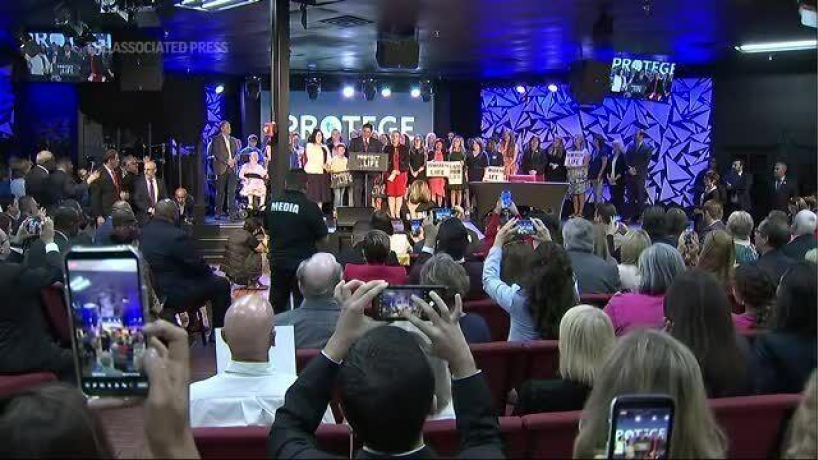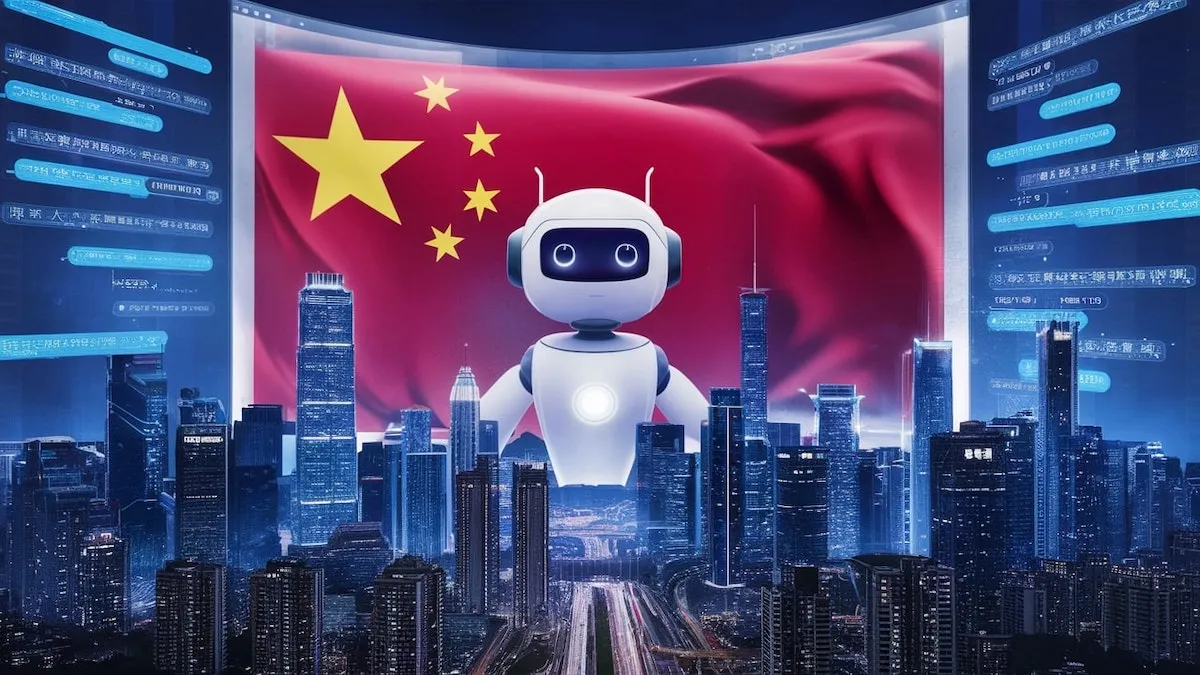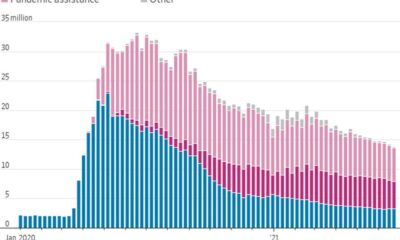Latest
Florida Gov DeSantis signs 15-week abortion ban | Latest News
Neque porro quisquam est, qui dolorem ipsum quia dolor sit amet, consectetur, adipisci velit, sed quia non numquam eius.

Florida Gov. Ron DeSantis signed a 15-week abortion ban into law Thursday as the state joined a growing conservative push to restrict access ahead of a U.S. Supreme Court decision that could limit the procedure nationwide.
The new law marks a significant blow to abortion access in the South, where Florida has provided wider access to the procedure than its regional neighbors.
The new law, which takes effect July 1, contains exceptions if the abortion is necessary to save a mother’s life, prevent serious injury or if the fetus has a fatal abnormality. It does not allow for exemptions in cases where pregnancies were caused by rape, incest or human trafficking. Under current law, Florida allows abortions up to 24 weeks.
Get up-to-the-minute news sent straight to your device.
Featured
India and Pakistan Agree to Ceasefire Amid Rising Tensions

On May 10, 2025, the world breathed a cautious sigh of relief as India and Pakistan, two nuclear-armed neighbors with a long history of hostility, agreed to a ceasefire following a series of escalations that threatened to ignite a full-scale war in South Asia.
The Trigger: A Devastating Attack
The conflict reignited after a tragic terrorist attack in the Indian-administered region of Kashmir left 26 civilians dead. The assault, which targeted a busy market in the city of Srinagar, immediately raised suspicions within Indian intelligence circles, who blamed Pakistan-based militant group Jaish-e-Mohammed. India swiftly condemned the attack, calling it a “cowardly act of terror” and vowed to respond with force.
Retaliation and Escalation
Within 48 hours of the attack, India launched a series of targeted missile strikes on what it claimed were militant training camps in Pakistan-administered Kashmir. The air raids resulted in multiple casualties and further inflamed tensions between the two countries. Pakistan responded with its own military mobilization and threats of retaliation, pushing the region to the brink of war.
For days, military analysts and diplomats around the globe watched with increasing concern. Social media lit up with reports of troop movements, blackouts in border towns, and intercepted communications suggesting a possible escalation to conventional warfare. The international community, particularly the United Nations and regional allies like China and the United Arab Emirates, called for immediate de-escalation.
A Surprising Diplomatic Intervention
In a twist that caught many off-guard, former U.S. President Donald Trump stepped in as an unofficial mediator. Leveraging his prior relationships with both Indian and Pakistani leaders from his time in office, Trump initiated a series of behind-the-scenes discussions. According to insiders, the former president made multiple phone calls and engaged in shuttle diplomacy to broker peace.
Critics questioned Trump’s involvement, but even skeptics admitted that his intervention appeared to cool tempers. The talks culminated in an agreement between Indian Prime Minister Arvind Reddy and Pakistani President Ahsan Qureshi to observe a full ceasefire starting immediately.
Terms of the Ceasefire
The agreement included several key components:
- Immediate halt to all military actions along the Line of Control (LoC).
- Establishment of a joint investigation into the Kashmir attack, with representatives from both nations and neutral observers.
- Reinstatement of diplomatic backchannels that had gone cold since 2023.
- A scheduled summit in Geneva in July 2025 to discuss long-term peace frameworks and cross-border terrorism.
Indian Defense Minister Nikhil Menon confirmed the ceasefire in a televised address, stating, “While we will never tolerate terrorism, we recognize the importance of dialogue in preventing further loss of life.”
Reactions at Home and Abroad
Domestically, reactions were mixed. Indian nationalists criticized the government for not pursuing a more aggressive stance, while peace advocates praised the leadership for prioritizing diplomacy over war. In Pakistan, President Qureshi faced both praise for preventing escalation and criticism for conceding too quickly under international pressure.
Global leaders, including UN Secretary-General Antonio Guterres, applauded the ceasefire as a step in the right direction. China issued a statement urging both countries to continue working toward peaceful solutions, while Russia offered to host future peace talks.
What’s Next?
While the ceasefire has brought temporary calm, the underlying issues remain unresolved. The Kashmir region continues to be a flashpoint, and both nations harbor deep mistrust. Experts warn that without substantial policy changes and mutual agreements, future flare-ups are inevitable.
Still, the May 10 ceasefire is a reminder of the power of diplomacy—even when led by unexpected figures. Whether this truce holds or falters will depend on the upcoming Geneva summit and the political will of both nations to choose peace over provocation.
For now, South Asia watches and waits.
Featured
China’s Strategic Clapback: How Luxury Brand Exposure Became an Economic Retaliation Tool
China claps back on the United States

In the wake of escalating tariff tensions between the United States and China, a new form of economic retaliation has emerged—one that doesn’t involve additional taxes, embargoes, or diplomatic statements. Instead, China has turned to social media and transparency as its sharpest tools. What began as viral content on platforms like Douyin (China’s version of TikTok) has become a calculated, highly effective campaign revealing the true cost structures and manufacturing origins of Western luxury products.
The results? Consumer backlash, brand skepticism, and a major shake-up in global perceptions of luxury.
The Backdrop: U.S. Tariffs and China’s Silent Response
The U.S. recently imposed a new wave of tariffs targeting Chinese imports—ranging from electric vehicles to critical components used in renewable energy and technology sectors. Instead of responding through traditional government channels, China opted for a culturally resonant and strategically disruptive response: peeling back the curtain on the luxury goods Americans hold dear.
Through viral videos, Chinese factory workers, influencers, and content creators have started showcasing the real production costs and assembly processes behind designer items sold by global brands like Hermès, Gucci, Chanel, and others. The content, often presented in side-by-side comparisons of production cost versus retail price, has gone viral on both Douyin and TikTok, resonating with a global audience of skeptical, budget-conscious consumers.
Revealing the Margins: From $100 Manufacturing to $10,000 Price Tags
One widely shared video displayed the step-by-step manufacturing of a Hermès-inspired handbag, noting that its production cost was approximately $120 USD. The retail equivalent of the same bag? Upwards of $12,000. Similar videos have shown luxury sneakers being produced for under $30, designer belts for less than $20, and branded jewelry created from base materials available at a fraction of retail prices.
The implications are far-reaching. For decades, luxury brands have justified their price points through the appeal of exclusivity, craftsmanship, and brand legacy. However, this transparency campaign is effectively undercutting that narrative by focusing the spotlight on the reality of outsourced labor and inflated margins.
Psychological Warfare Through Transparency
While the move may appear grassroots, industry analysts suggest this surge of transparency is anything but random. It comes at a time when the Chinese government is tightening its internal regulations on displays of wealth and pushing for greater domestic modesty in personal consumption. At the same time, this exposure allows China to assert quiet leverage in the ongoing trade war.
By revealing that many luxury products sold in the West are, in fact, manufactured in China—often in the very factories now subject to tariffs—China is flipping the power dynamic. It’s a reminder to Western consumers and lawmakers alike: China is not merely a source of low-cost goods—it is also the backbone of many of the West’s most celebrated brands.
This form of “soft retaliation” is strikingly effective. Rather than targeting governments, it targets perceptions. And in an era where brand reputation can swing markets, perception is everything.
Consumer Reaction: Disillusionment and Demand for Accountability
As these revelations gain traction, social media has become a hotbed of discussion. Consumers, especially younger generations, are questioning the true value of the luxury items they once saved up for. Comments across platforms express a common theme: disillusionment.
Many are calling for more ethical transparency in pricing models and supply chain management. The exposure has also triggered interest in alternative luxury, such as direct-to-consumer models and brands that prioritize authenticity and fair labor practices.
This shift presents both a challenge and an opportunity for global luxury brands. The challenge: rebuilding consumer trust. The opportunity: reintroducing their value in a way that withstands scrutiny—not just from regulators, but from an increasingly informed customer base.
Broader Implications for the Luxury Market
The luxury industry is built not only on materials and labor, but on perception. Prestige, quality, and exclusivity are carefully curated attributes that command high margins. The current wave of manufacturing transparency challenges the very foundation of that perception.
As global consumers become more aware of product sourcing and true cost structures, brands will be forced to adapt. This may lead to:
- A deeper investment in domestic manufacturing to regain trust
- Greater openness about pricing models and ethical practices
- Stronger marketing around craftsmanship and quality assurance
At the same time, this may also accelerate the decline of blind brand loyalty. Consumers are already turning toward values-based shopping, and this transparency push could expedite that shift.
Conclusion: Economic Strategy Reimagined
China’s decision to allow—or at least not suppress—the mass exposure of U.S. luxury brands’ production realities is a masterclass in modern economic strategy. It sidesteps direct confrontation and instead wields cultural and consumer influence as tools of power. Rather than imposing tariffs of its own, China has placed the burden of response on Western companies and the consumers they serve.
As the global economy becomes more interconnected and more visible, traditional forms of economic retaliation may give way to perception-based strategies. In this case, China has sent a message loud and clear: If you’re going to tax our exports, don’t be surprised when we reveal what your imports are really made of.
Featured
China’s Rising AI Powerhouses: Who’s Coming for DeepSeek’s Crown?

As China races to lead the global artificial intelligence boom, a new generation of AI players is rising—fast. While DeepSeek may currently wear the crown, several ambitious tech titans and scrappy startups are hot on its heels. From generative text to powerful multi-modal models, these companies are building smarter, faster, and more accessible AI—ready to compete not just at home, but globally.
1. Alibaba Cloud’s Qwen 2.5-Max: Big Tech, Bigger Ambitions
Alibaba has entered the AI arms race with Qwen 2.5-Max, a large language model that already claims to outperform rivals like Meta’s LLaMA and OpenAI’s GPT in key areas. Backed by Alibaba Cloud, this model is fast becoming a key asset in China’s push for AI dominance, offering enterprise-grade power with regional language fluency.
2. Moonshot AI’s Kimi k1.5: The Long-Context Contender
Moonshot AI’s Kimi k1.5 is earning serious attention for its ability to handle prompts with up to 2 million Chinese characters—yes, million. That’s a massive leap for long-context processing and could revolutionize how businesses handle large-scale data analysis, legal contracts, and scientific documents.
3. ByteDance’s Doubao-1.5-pro: The TikTok Giant Goes Deep Tech
Better known for TikTok, ByteDance is now flexing its AI muscles with Doubao-1.5-pro. The model promises competitive performance while keeping costs low—a direct swipe at OpenAI’s pricing model. It’s ByteDance’s clear signal that they’re not just playing in the consumer space anymore.
4. Tencent’s Hunyuan: AI That Fits in Your Pocket
Tencent is betting on accessibility with Hunyuan, a multi-modal AI engine that can turn text into video, generate content, and deliver results on mobile devices. With integration into WeChat and impressive rankings in Chinese app stores, Hunyuan is blending everyday convenience with deep AI capabilities.
5. Baidu’s Ernie Models: Smarter, Cheaper, Faster
Baidu isn’t sitting idle. With the release of Ernie X1 and the upgraded Ernie 4.5, it’s carving out space for powerful, cost-effective alternatives to DeepSeek. These models are trained not just for performance, but also to understand emotional cues—a nod to the growing demand for AI that feels more human.
6. Manus by Monica: One Prompt, Endless Action
The underdog in this race may be the most interesting. Manus, developed by AI startup Monica, acts like an autonomous agent capable of handling full workflows from a single prompt. While skeptics are calling it overhyped, its potential to reshape productivity tools and customer service is worth watching.
The Takeaway?
DeepSeek might have kicked down the door, but China’s AI boom is just getting started. Whether it’s Alibaba’s enterprise precision, Moonshot’s long-context wizardry, or Tencent’s consumer-friendly AI in your pocket, these companies aren’t just following the leader—they’re aiming to become one.
Keep watching. The next AI world leader might already be live, running quietly in an app on someone’s phone in Shanghai.
-

 Featured9 months ago
Featured9 months ago20 Entrepreneurs to Watch Closeout 2024
-

 Innovation1 year ago
Innovation1 year agoLeo Horacio: A Successful Entrepreneur in the Ecommerce and Online Sales Industry
-

 Innovation12 months ago
Innovation12 months agoInnovators in Social-Emotional Learning: Dr. Myava Clark and Chris Clark Jr.
-

 Latest11 months ago
Latest11 months agoCharles zhang recognized by forbes as #1 on michigan’s 2022 best in state wealth advisor list
-

 Lifestyle1 year ago
Lifestyle1 year agoPhillip Austin brings outlaw country to General Duffy’s stage – The Bulletin
-

 Music12 months ago
Music12 months agoArtist Deydee Signs $350,000 Contract with Rueda Empire LLC
-

 Small Business10 months ago
Small Business10 months agoSmall Business Labor Shortage – Forbes
-

 Uncategorized7 months ago
Uncategorized7 months agoTrailblazer in Business: Alicia Fitts on Building Wealth and Community Through Faith







